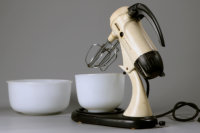Sunbeam Mixmaster, 1959
2002/12


Sunbeam
This Mixmaster was made by the Sunbeam Corporation in Sydney. Sunbeam had started in 1902 as an Australian branch of the Chicago Flexible Shaft Company. Originally established to manufacture sheep shearing equipment, they began producing kitchen appliances in 1946. The Mixmaster was Sunbeam’s first and most popular domestic product.Labour
Electric appliances like this Mixmaster made the job of housework easier. Before their availability, housework was physically demanding and performed mainly by women. Whilst these new electric appliances didn’t shift these unpaid responsibilities away from women, they did save time. This provided women with new opportunities for study, activism and paid work.Bakelite
Parts of this Mixmaster are made of Bakelite, the world’s first synthesised plastic. Bakelite was developed by Belgian-American chemist Leo Baekeland in New York in 1907. It was fast to produce, heat resistant and didn’t conduct electricity. This made it a useful material for manufacturing kitchen appliances, radios and telephones.Odour
Machinery powered by older electric motors, like this Mixmaster, produce a distinctive odour when in use. This smell emerges from two sources. The first is ozone produced by electricity arcing inside the motor. The second is graphite. As the Mixmaster heats up during use the graphite in the motor vaporises

Sunbeam Mixmaster, 1959
2002/12


Sunbeam
This Mixmaster was made by the
Sunbeam Corporation in Sydney.
Sunbeam had started in 1902 as
an Australian branch of the Chicago
Flexible Shaft Company. Originally
established to manufacture sheep
shearing equipment, they began
producing kitchen appliances in 1946.
The Mixmaster was Sunbeam’s first
and most popular domestic product.
Labour
Electric appliances like this Mixmaster
made the job of housework easier.
Before their availability, housework
was physically demanding and
performed mainly by women.
Whilst these new electric appliances
didn’t shift these unpaid
responsibilities away from women,
they did save time. This provided
women with new opportunities
for study, activism and paid work.
Bakelite
Parts of this Mixmaster are made
of Bakelite, the world’s first synthesised
plastic. Bakelite was developed
by Belgian-American chemist Leo
Baekeland in New York in 1907.
It was fast to produce, heat resistant
and didn’t conduct electricity.
This made it a useful material for
manufacturing kitchen appliances,
radios and telephones.
Odour
Machinery powered by older electric
motors, like this Mixmaster, produce
a distinctive odour when in use.
This smell emerges from two sources.
The first is ozone produced by
electricity arcing inside the motor.
The second is graphite. As the
Mixmaster heats up during use
the graphite in the motor vaporises.


